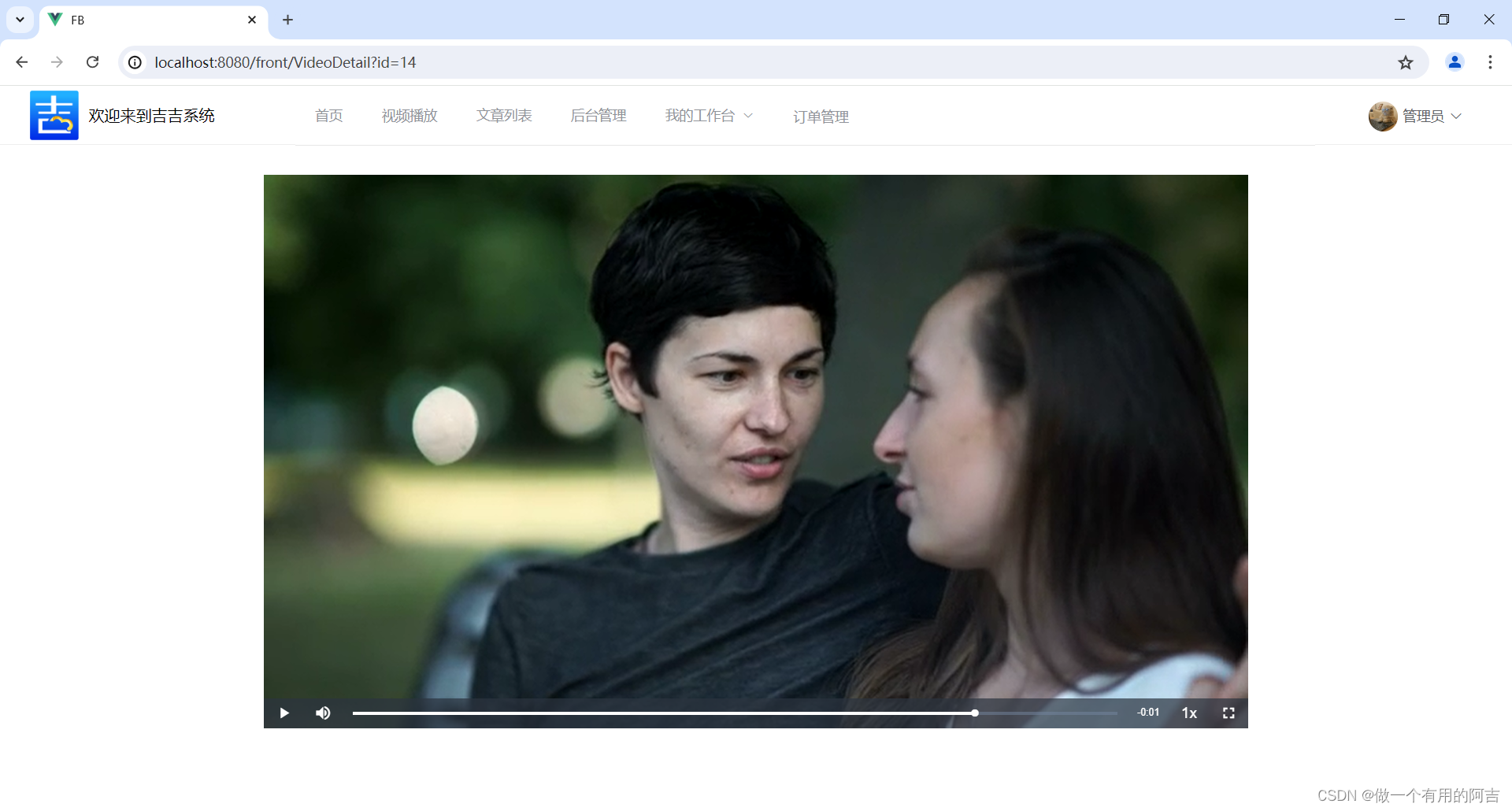项目实战第二十一记
- 写在前面
- 1. springboot文件默认传输限制
- 2. 安装视频插件包命令
- 3. 前台Video.vue
- 4. 创建视频播放组件videoDetail.vue
- 5. 路由
- 6. 效果图
- 总结
- 写在最后
写在前面
本篇主要讲解系统集成视频播放插件
1. springboot文件默认传输限制
在application.yml文件中添加如下配置,保障能够上传视频文件(防止文件超出大小报错)
Spring Boot默认的文件上传大小限制是1MB
servlet:multipart:max-file-size: 100MB #设置传输文件最大大小max-request-size: 100MB #设置请求大小
2. 安装视频插件包命令
# 安装命令
npm install vue-video-player@5.0.2 --save // 注意安装的版本
npm install video.js
3. 前台Video.vue
在前台目录文件下,创建视频管理页面
<template><div style="padding: 10px"><el-card><div v-for="item in videos" :key="item.id" style="margin: 10px 0; padding: 10px 0; color: #666; border-bottom: 1px dashed #ccc"><span style="font-size: 18px; cursor: pointer" class="item" @click="detail(item.id)">{{ item.name }}</span><span style="float: right; font-size: 12px; margin-top: 10px">文件大小:{{ item.size }} kb</span></div></el-card></div>
</template>
<script>
export default {name: "video",data(){return {videos: [],};},created(){this.getList()},methods:{getList(){this.request.get('/file/video').then(res => {// console.log(res);this.videos = res.data.filter(v => v.type == 'mp4');})},// 查看视频detail(id){this.$router.push({path: '/front/videoDetail', query: {id: id}});}}
}
</script>
<style scoped>
.item:hover {color: skyblue;background: none;
}
</style>
4. 创建视频播放组件videoDetail.vue
<template><div style="margin: 30px auto;"><div class='demo'><video-player class="video-player-box"ref="videoPlayer":playsinline="true":options="playerOptions"></video-player></div></div>
</template>
<script>
import 'video.js/dist/video-js.css'
import { videoPlayer } from 'vue-video-player'export default {name: "videoDetail",components: {videoPlayer},data(){return {playerOptions: {playbackRates: [0.5, 1.0, 1.5, 2.0], // 可选的播放速度autoplay: true, // 如果为true,浏览器准备好时开始回放。muted: false, // 默认情况下将会消除任何音频。loop: false, // 是否视频一结束就重新开始。preload: 'auto', // 建议浏览器在<video>加载元素后是否应该开始下载视频数据。auto浏览器选择最佳行为,立即开始加载视频(如果浏览器支持)language: 'zh-CN',aspectRatio: '16:9', // 将播放器置于流畅模式,并在计算播放器的动态大小时使用该值。值应该代表一个比例 - 用冒号分隔的两个数字(例如"16:9"或"4:3")fluid: true, // 当true时,Video.js player将拥有流体大小。换句话说,它将按比例缩放以适应其容器。sources: [{type: "video/mp4", // 类型src: '' // url地址}],poster: '', // 封面地址notSupportedMessage: '此视频暂无法播放,请稍后再试', // 允许覆盖Video.js无法播放媒体源时显示的默认信息。controlBar: {timeDivider: true, // 当前时间和持续时间的分隔符durationDisplay: true, // 显示持续时间remainingTimeDisplay: true, // 是否显示剩余时间功能fullscreenToggle: true // 是否显示全屏按钮}}};},created(){this.playVideo()},methods:{playVideo(){// 获取url上的参数let id = this.$route.query.id;this.request.get('/file/detail/'+id).then(res => {this.playerOptions.sources[0].src = res.data.url;})}}
}
</script>
<style scoped></style>
提取的公共部分(供以后直接使用)
<div class='demo'><video-player class="video-player-box"ref="videoPlayer":playsinline="true":options="playerOptions"></video-player></div>
playerOptions: {playbackRates: [0.5, 1.0, 1.5, 2.0], // 可选的播放速度autoplay: true, // 如果为true,浏览器准备好时开始回放。muted: false, // 默认情况下将会消除任何音频。loop: false, // 是否视频一结束就重新开始。preload: 'auto', // 建议浏览器在<video>加载元素后是否应该开始下载视频数据。auto浏览器选择最佳行为,立即开始加载视频(如果浏览器支持)language: 'zh-CN',aspectRatio: '16:9', // 将播放器置于流畅模式,并在计算播放器的动态大小时使用该值。值应该代表一个比例 - 用冒号分隔的两个数字(例如"16:9"或"4:3")fluid: true, // 当true时,Video.js player将拥有流体大小。换句话说,它将按比例缩放以适应其容器。sources: [{type: "video/mp4", // 类型src: '' // url地址}],poster: '', // 封面地址notSupportedMessage: '此视频暂无法播放,请稍后再试', // 允许覆盖Video.js无法播放媒体源时显示的默认信息。controlBar: {timeDivider: true, // 当前时间和持续时间的分隔符durationDisplay: true, // 显示持续时间remainingTimeDisplay: true, // 是否显示剩余时间功能fullscreenToggle: true // 是否显示全屏按钮}}
5. 路由
{path: 'video',name: '视频管理',component: () => import('../views/front/Video.vue')
},
{// 在JavaScript本身以及大多数前端路由库(如React Router, Vue Router等)中,路由路径匹配时不区分大小写。// 所以,无论是'person'还是'Person'作为路径定义,用户访问时输入/person或/Person理论上都应能匹配到相同路由path: 'videoDetail',name: '视频播放',component: () => import('../views/front/VideoDetail.vue')
},
6. 效果图

总结
今天是此项目的最后一篇了,如果还有更新,可能是时间富余想加点什么功能;不过个人认为这个项目做到现在,差不多了。
写在最后
如果此文对您有所帮助,请帅戈靓女们务必不要吝啬你们的Zan,感谢!!不懂的可以在评论区评论,有空会及时回复。
文章会一直更新,后续会开启新的项目篇章


处理粘包)



)










)

